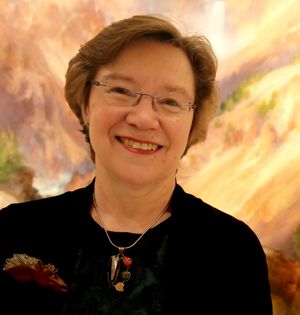SMITHSONIAN AMERICAN ART MUSEUM AND THE RENWICK GALLERY
Inauguration Highlights Rainbow Painting by African American Artist
Curator Eleanor Harvey shares the story of Robert Duncanson and his artwork
Curator Eleanor Jones Harvey shares the story of Robert S. Duncanson

A bucolic scene from SAAM’s permanent collection, Landscape with Rainbow (1859) by Robert S. Duncanson, was on display January 20, 2021 at the US Capitol as part of the inaugural events. The painting was selected by First Lady Dr. Jill Biden and Senator Roy Blunt to reflect the theme of the 59th annual ceremonies—“Our Determined Democracy: Forging a More Perfect Union”—and was intended to hang behind the head table for the traditional welcome luncheon for the new President and Vice President. (The event was re-envisioned due to the COVID-19 pandemic.) Eleanor Jones Harvey, senior curator at the Smithsonian American Art Museum, shares some insights into this artwork.
Robert Seldon Duncanson (1821–1872) was America’s best known African American painter in the years surrounding the Civil War. His parents moved the family from Virginia to Fayette, New York, near Seneca Falls, where Duncanson was born. In 1840 at the age of 19, the artist moved to Cincinnati, then the largest and most prosperous city on the western frontier. By the 1850s the “Queen City” had developed a reputation for its pro-abolitionist leanings. But even here Duncanson walked a fine line, acknowledging his heritage without flaunting it. Duncanson worked hard to make a decent living and raise a family working as an artist of color during the antebellum and Civil War years.
Cincinnati was home to a substantial group of prominent abolitionists, among them Rev. Francis Conover, James Birney, Nicholas Longworth, Rev. Charles Avery, Freeman Cary, and Rev. Richard Rust, all of whom were among the artist’s patrons. During the 1840s Lyman Beecher and his family—including daughter Harriet and son Henry Ward Beecher —were friends and fellow residents. Stowe and her brother left for Boston shortly before she wrote Uncle Tom’s Cabin; however, their ties to Cincinnati meant it was highly likely Duncanson, and many of his patrons, read the book in serial form and saw one of the early plays. Local abolitionist journals took pride in pointing out Duncanson’s accomplishments as evidence of the capabilities of African Americans.
The Civil War made it increasingly difficult for Duncanson to feel comfortable even in Cincinnati, and by 1863 the artist had moved with his family to Montreal. There he was in good company; Canada was a terminus of the Underground Railroad. Even Frederick Douglass had headed north of the border after John Brown’s raid on Harper’s Ferry in 1859, when his arrest seemed imminent. Cincinnati had long been an important stop on the Underground Railroad. Across the river was Covington, Kentucky, and between them flowed the Ohio River. For many who escaped, the Ohio River represented the last obstacle to freedom. It was across that river that Stowe’s character Eliza escaped with her infant daughter, crossing the ice floes that choked the river at the height of winter.
The topography of Duncanson’s Landscape with Rainbow evokes the Covington/Cincinnati region. When it was exhibited in 1859, a reviewer praised it as "one of the most beautiful pictures painted on this side of the [Allegheny] mountains." The bucolic vista over which the rainbow arches suggests a scene imbued with hope, providing a pictorial end of the rainbow towards which the couple walks. Duncanson painted this landscape on the eve of Civil War, a reminder of the power of landscape painting to convey America’s cultural aspirations. Duncanson presents this scene as a vision of future peace and prosperity regardless of race—an aspiration we all should embrace.

